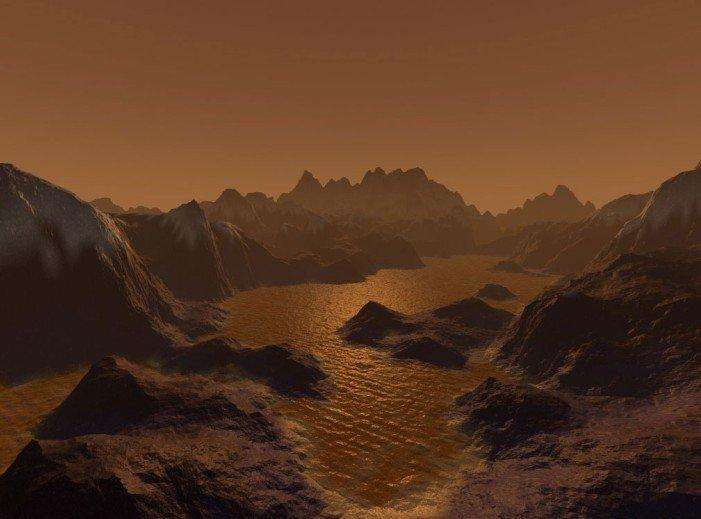(单词翻译:单击)
Scientists are sending a submarine to Saturn's moon Titan to explore its alien oceans
科学家正派遣一艘潜艇前往土星的卫星泰坦星探索其外星海洋,
in search for life and to possibly understand how life began on our own planet!
寻找生命,可能的话,顺便了解生命在我们自己的星球上是如何开始的。
Researchers are studying two main oceans on the moon Titan.
研究人员正在研究泰坦的两大海洋:
The Kraken Mare and Ligeia Mare.
Kraken Mare海和Ligeia Mare海。
Both of which were discovered fairly recently by the Cassini space probe.
两者都是卡西尼太空探测器最近才发现的。
Ligeia Mare is less than 200 meters deep.
Ligeia Mare海的深度不到200米。
But the Kraken Mare, we don't know how deep it is.
但Kraken Mare海,我们就不知道它有多深了。
So sending this Submarine could answer a lot of questions including the depth.
所以派潜艇过去能够回答很多问题,包括Kraken Mare海的深度。
Titan might also answer some geological questions about our planet,
探索泰坦也可能帮助回答关于我们自己的星球的一些地理问题,
because Titan is composed of a nitrogen-rich atmosphere…
因为泰坦的空气中富含氮气,
it also has seasonal cycles, ocean waves, possible ice water, landscape erosions, and a hot rocky core,
它也有季节性的周期,海浪,可能的冰水,地表侵蚀和高温岩石内核,
which all sounds very familiar, it seems to have a lot in common with with our own planet, Earth.
这些特征听起来都很熟悉,换句话说,这个星球似乎与我们自己的地球有许多相似之处。
The goal is to have the submarine dive deep into the oceans and look at heavy metals that might have settled to the bottom.
此次探索的目标是让潜艇潜入海洋深处,观察可能沉降到底部的重金属。
They'll use a mass spectrometer to measure the elements and see what they’re made of.
他们将用质谱仪来测量元素并查看它们的构成。
In order to gather this data, the submarine will have to be prepared for these mysterious and icy cold oceans on the moon.
为了获取这方面的数据,潜艇必须做好应对行星上这些神秘和冰冷的海洋的准备。
And of course, there are obstacles to that.
当然了,这方面也是有困难的。
The pressure on Titan, for example, is about 60% more than on Earth, about the same pressure as at the bottom of a swimming pool.
例如,泰坦上的气压比地球上大将近60%,大约与游泳池底部的压强相同。
So, researchers at Washington State University partnered with NASA to try and re-create the oceans of Titan, but in a lab here on Earth.
因此,华盛顿州立大学的研究人员便同美国航天局一起尝试重建泰坦海洋的环境,只不过这一切都是在地球上的一个实验室里展开的。
They did this by building a pressurized chamber
为此,他们构建了一个加压室
and filling it with liquid methane, liquid ethane, and nitrogen gas to simulate the environment on Titan.
往里面充满液态甲烷,液态乙烷和氮气,从而模拟泰坦的环境。
Then they cooled it to about -150 degrees C to get a mini-Titan ocean!
然后,他们将其冷却至零下150摄氏度,创造一个迷你泰坦海洋!
Inside they were able to test possible space-going equipment.
他们能够在里面测试一些可能会送往泰坦的空间设备。
For example, they engineered a borescope and a video camera that could withstand the super cold temperatures and high pressures on Titan.
比如,他们设计了一个能够承受泰坦超低温和高压的内窥镜和摄像机。
But unlike other probes, we can’t rely on solar power for this mission,
然而,与其他探测器不同的是,我们不能依靠太阳能来完成这次任务,
so they’re planning on installing instead an RTG--or Radioisotope Thermoelectric Generator.
所以他们计划换成一台RTG,也就是放射性同位素热电发电机。
Basically, this sucker is nuclear.
从本质上来讲,这个吸盘堪称整个设备的核心。
The challenges of engineering a submarine to head to another moon is just astronomical to use exactly the right word.
准确来讲,设计一艘潜艇并将其送往另一个行星所面临的挑战可以说是天文数字。
But hopefully we're going to answer a lot of unanswered questions
但,我们还是有望回答很多尚未得到解答的,
about how life began on our own planet, and possibly life in our solar system.
关于生命如何在我们的星球上,或许也可以说是在我们的太阳系中开始的问题。
For more on this submarine, check out our sister show Space Crafts here!
欲了解更多关于这艘潜艇的信息,请查看我们的同期节目Space Crafts!
Please take a second and subscribe.
请花一点时间订阅我们的频道。
Scientists know how geochemistry happens on Earth by the way
尽管科学家知道地球上地球化学反应是如何开展的,
but don’t know how the process went from geo-chem to bio-chem.
但我们还不了解地球化学转变成生物化学的过程。
So hopefully studying Titan could tell us a lot more about how we got life on our planet.
所以,顺利的话,研究泰坦星可以告诉我们更多关于我们是如何在地球上获得生命的信息。
Thanks for watching.
感谢收看。


